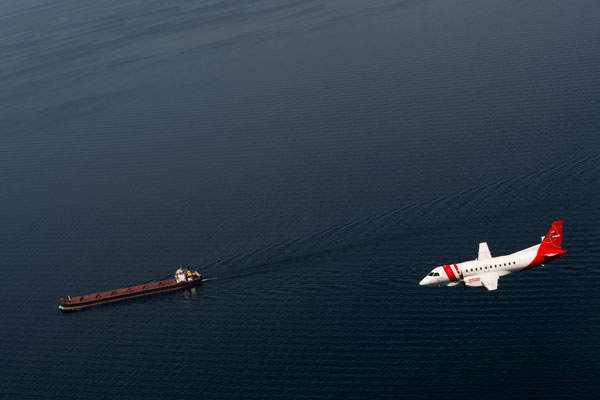The Saab 340 is a maritime surveillance aircraft (MSA) produced by Saab Group. The aircraft is intended to perform missions including personnel transportation, surveillance of coastal and blue waters, safeguarding, long-range search-and-rescue (SAR), medical evacuation (MEDEVAC), exclusive economic zone (EEZ) monitoring and illegal immigration control.
The aircraft will also be suitable for oil spill and pollution detection, fisheries inspection and management, and counter-smuggling surveillance missions.
Saab rolled out the 340 MSA in June 2012 displaying it for the first time at the Aerospace Forum Sweden 2012 in Linköping. The aircraft was unveiled at the Farnborough International Airshow in England in July 2012.
Saab also exhibited the aircraft at the Africa Aerospace and Defence exhibition (AAD) 2012 in South Africa. The capabilities of the MSA were also demonstrated at the Dubai Airshow in November 2013.
Design and features of Saab 340 MSA
The 340 MSA is a complete airborne surveillance system designed based on civil Saab 340 aircraft. The MSA is part of Saab’s Airborne Surveillance family offering flexible and reliable coastal security solutions for the operators.
The aircraft integrates a re-manufactured fuselage to meet the operational requirements. The new platform delivers maximum performance at minimum cost.
The 340 MSA can operate independently or in cooperation with other marine and land-based assets. The surveillance aircraft can monitor large maritime areas during day and night in all weather conditions.
In June 2004, the US Navy announced the selection of the Boeing multimission maritime aircraft, 737 MMA, and awarded a contract to Boeing for the system development and demonstration phase of the programme for the US Navy’s next-generation maritime surveillance aircraft.
Cabin layout of the Saab aircraft
The aircraft cabin can be configured according to the requirements of the customers. The external layout of the cabin integrates a spray wash system, large optical observer window, maritime surveillance radar, electro-optical sensor, and air drop door.
The internal layout houses galley, mission controller console, lavatory, mission equipment avionics rack, SAR liferaft stowage, air drop door, crew rest area and observer positions.
The crew rest area and observer positions will be replaced with the passenger seats when the aircraft is used for transporting government or police personnel.
Sensors and communication systems aboard the Saab 340
The mission management system (MMS) installed aboard the Saab 340 incorporates remote sensors and mission system components into a single user-friendly framework. It provides the aircraft with real-time display of sensor information, display of electronic charts, automated scene analysis and in-flight and ground processing.
The MMS also offers mission planning, immediate post-overpass analysis, support for remote sensors, classification of marine pollution, automated scene analysis, computer-aided report creation, geo-referencing and GIS capability, redundant storage and aircraft information system (AIS) support.
The aircraft is equipped with a retractable multiple StarSaphire HD EO/IR sensor. The Telephonics 1700B maritime surveillance radar onboard provides 360° coverage for multiple target identification, detection and tracking during over-water surveillance. The advanced sensors allow the aircraft to detect, classify and identify maritime surface contacts.
The Saab R4 airborne automatic identification system (AIS) transponder offers improved situational awareness to the operator during surveillance and SAR. The aircraft can be optionally fitted with a side-looking airborne radar (SLAR) and UV/IR line scanner for environmental monitoring.
A wireless broadband system with Internet connections is fitted in the crew rest area table in order to transmit information securely through wireless systems. The VHF/UHF tactical radio communication system facilitates a complete multi-band solution for law enforcement, military, medical, marine, SAR and public-service frequencies.
The satellite communication (SatCom) voice and data link enables data transfer via virtual private network (VPN), e-mail, telephone, internet browsing and video streaming over the Internet Protocol (IP).
The MSA is also equipped with a V/UHF direction finder that locates the targets in SAR missions. It covers the commercial airborne and maritime VHF radio band and Cospas Sarsat distress signals.
Saab 340 MSA performance
The multi-role Saab 340 MSA can fly at a maximum cruise speed of 265kt and patrol speed of 140kt. The maximum range of the aircraft is 1,715nm and the take off distance is 1,350m.
The aircraft can fly at a maximum altitude of 25,000ft and can reach a height of 10,000ft in just five minutes. It has a maximum airborne endurance of up to 5.4 hours while patrolling at 200nm to exclusive economic zone area. The aircraft can operate for up to nine hours when fitted with auxiliary fuel tank.








.gif)




